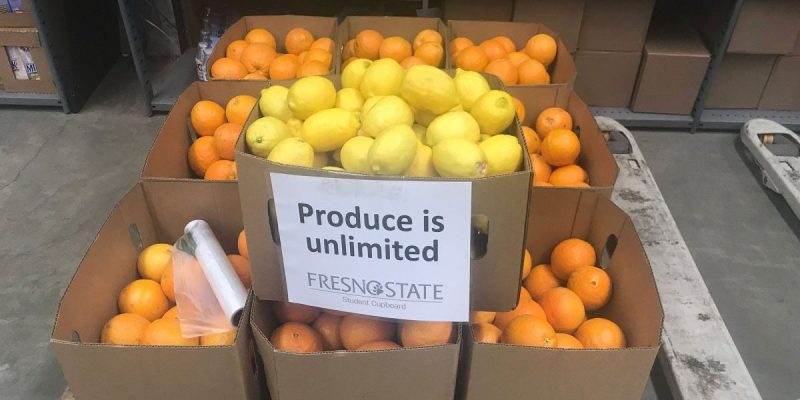
Above Photo: Boxes of oranges and lemons at a food pantry at a California college. Far too many students lack reliable access to nutritious food. Wayne D’Orio for The Hechinger Report.
Let’s identify barriers and find ways to remove them.
The pandemic has created extraordinary need for millions of people across the U.S. This is particularly acute, though often hidden, on college campuses, where students are sometimes left to choose between paying rent and having enough to eat.
During their college careers, far too many students lack reliable access to nutritious food, hampering their efforts to advance their education and skills.
Even before the pandemic, 43 percent of students at two- and four-year colleges reported facing food insecurity — defined as limited or uncertain access to adequate food — in the previous month, the nonprofit Hope Center found. Black, Latino and Native American students were at even greater risk. This inequality compounds systemic economic disparities.
A student wondering where their next meal will come from must overcome daunting obstacles when it comes to focusing on their studies — to say nothing of completing a degree.
To better understand the challenge facing students during the pandemic, I led a team of university administrators who interviewed hundreds of students, faculty and staff to identify the causes of hunger on campuses.
Drawing on these interviews, our research found that there are actions that institutions and policymakers can take to address students’ lack of access to nutritious food. These start with spreading the word about student needs and partnering with communities to expand resources beyond traditional food pantries. If we advance institutional change and public policy changes, colleges and policymakers can make immense progress in the fight against food insecurity on campus.
Addressing hunger requires demystifying who faces it. Traditional markers of food insecurity such as socioeconomic status, race, ethnicity and gender do not tell the whole story.
Our study showed that food insecurity manifests in a variety of forms, including forgoing meals, eating an imbalanced diet, skipping classes, utilizing university emergency funds and accessing food pantries on campus. In essence, any student can exhibit these behaviors, and can face hunger at any point. Many students feel stigma or guilt about gaining access to university resources and choose to forgo them for fear of being labeled poor by their peers. Some worry about exhausting food resources for other students who they believe are facing more dire circumstances.
That’s why, along with providing resources to students and promoting the resources’ availability, we must also normalize the use of university supports aimed at addressing students’ needs.
Engaging partners outside of the campus community is also key. College students often work, volunteer and raise families beyond the confines of campus. By teaming up with local partners, institutions can connect students with resources to help them meet not only their food needs, but also other often interconnected basic needs, including housing.
The State University of New York at Albany has taken this partnership approach with important results. Through a collaboration with its regional food bank and local pantries, the university says that it has provided more than 50,000 meals to students and community members in the last year alone.
The University of Toledo in Ohio is partnering with its food service provider to recover unused food from catered events on campus and redirect it to students. By using a meal-alert system, administrators say that they saved 12,000 pounds in food waste in the program’s first year while improving food security.
Students also need better access to and knowledge about nutrition and food preparation to achieve lasting food security. That’s why, in addition to offering food and hygiene items, the food resource center at Morgan State University in Maryland provides cooking demonstrations, nutrition education and transportation assistance to local grocery stores.
By providing holistic supports for those taking advantage of food resources, institutions can make sure that students not only have enough to eat, but also have the knowledge and resources to sustain their access to food — allowing them to focus more clearly on their academic work.
Policymakers can play a key role. Before the pandemic, an estimated one in five college students were eligible for federal support through the Supplemental Nutrition Assistance Program (SNAP).
Yet only 3 percent of students accessed that support. Changes are needed.
To help address the surge in food insecurity among college students, Congress temporarily expanded SNAP eligibility requirements through the end of the pandemic. Permanently increasing eligibility for federal programs and enhancing outreach efforts to students are two obvious areas for lawmakers to pursue to achieve progress in the fight against hunger. Institutions and communities, for their part can advance policies to support student access to resources that address hunger.
The challenges facing students are long-standing, but the pandemic has laid bare the scale and urgency of addressing them.
Acting to address these obstacles is not just critical to meeting students’ immediate basic needs. It’s imperative to ultimately achieving a higher education system in which all students have the support they need to succeed.
Related posts:
Views: 0
 RSS Feed
RSS Feed

















 September 24th, 2021
September 24th, 2021  Awake Goy
Awake Goy  Posted in
Posted in  Tags:
Tags: 
















